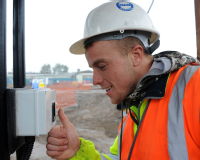Technology developed at
The technology is being rapidly taken up by the
Many other fingerprint techniques have tried to identify a few key features on a finger print and laboriously match them against a database of templates. The Warwick researchers consider the entire detailed pattern of each print and transform the topological pattern into a standard co-ordinate system.
This allows the researchers to 'unwarp' any fingerprint that has been distorted by smudging, uneven pressure, or other distortion and create a clear digital representation of the fingerprint that can then be mapped on to an 'image space' of all other fingerprints held on a database.
Instead of comparing a print against each entry in a database, any new print scanned by the system is unwarped and laid onto a virtual 'image space' that includes all the fingerprints available to the database. Whether there are a thousand or a million fingerprints in the database, the result comes back in seconds.
This technology, which has been commercialised by Warwick University spin-out company Warwick Warp, has recently been used by Data Collection Strategies (DCS), which has deployed it for security and staff management on six building sites.
Rodney Holland, managing director of DCS said: 'This is the first time I have seen a biometrics system that works reliably with the type of poor-quality fingerprints we see routinely in the construction industry. We have already installed Warwick Warp’s BioLog system at six major sites and our customers love it because it is fast, accurate and eliminates the 'buddy punching' problems of older, card-based access systems.'

In the past week, the system has also been examined by two of the world’s most respected technical fingerprint benchmarking tests. Tests by the National Physical Laboratory ranked Warwick Warp’s fingerprint technology best overall for accuracy. A test of 36 fingerprint technologies by the US National Institute of Standards and Technology (NIST) ranked Warwick third overall.
The unwarping is so effective that it also allows comparison of the position of individual sweat pores on a fingerprint. This has not previously been possible as the hundreds of pores on an individual finger are so densely packed that the slightest distortion prevented analysts from using them to differentiate fingerprints.




Swiss geoengineering start-up targets methane removal
No mention whatsoever about the effect of increased methane levels/iron chloride in the ocean on the pH and chemical properties of the ocean - are we...